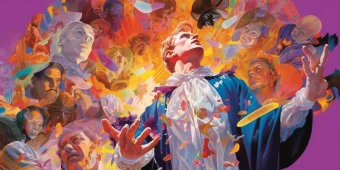by William Shakespeare


Othello Literary Analysis
Table of contents
- Setting
- Symbols
- Motifs
- Dramatic Irony
- Imagery
Setting
In Shakespeare's play Othello, setting plays an important role in creating the atmosphere and enhancing the themes of the story. The setting of Othello is primarily in two places: Venice, a cosmopolitan city of trade, and Cyprus, a remote and isolated island. Each location has its own distinct characteristics that contribute to the plot and the characters.
Venice serves as the setting for the first act of the play. It is a bustling city of trade and commerce, where the characters are introduced, and the initial conflict is established. It is a place of sophistication and luxury, where the wealthy and powerful hold sway. The use of Venice as the opening setting allows the audience to understand the cultural and social context of the play.
Cyprus, on the other hand, is a remote island where the main events of the play take place. It is a place of danger and isolation, where the characters are cut off from the rest of the world. The island is also symbolic of the characters' inner turmoil and psychological states. For example, Othello's descent into jealousy and rage mirrors the turbulent storms that ravage the island.
The contrast between the settings of Venice and Cyprus underscores the themes of the play. Venice represents the civilized world of reason and logic, while Cyprus represents the wild and untamed world of passion and emotion. The transition from Venice to Cyprus is a shift from order to chaos, as the characters struggle to maintain their composure in the face of mounting tension and conflict.
The use of setting also contributes to the characterization of the main characters. Othello is a Moor, an outsider in Venice, but in Cyprus, he is the commander of the military forces, which gives him a sense of authority and power. The shift in his status and the setting affects his behavior and actions, as he becomes more aggressive and impulsive.
Similarly, the setting of Cyprus affects the behavior of other characters as well. Iago, for example, thrives in the chaotic and lawless environment of the island. He uses the isolation of the island to his advantage and manipulates the characters in his schemes.
In conclusion, setting plays a significant role in Othello, enhancing the themes of the play and contributing to the development of the characters. The use of Venice and Cyprus as settings is symbolic of the characters' internal struggles and the shift from order to chaos. The isolation and danger of Cyprus accentuate the tension and conflict in the play, providing a fitting backdrop for the tragedy that unfolds.
Symbols
In Shakespeare's play Othello, symbols are used to represent various concepts and themes throughout the play. Symbolism in Othello is often complex, multilayered, and ambiguous, allowing for different interpretations and meanings.
One of the most prominent symbols in the play is the handkerchief. The handkerchief, given to Desdemona by Othello as a token of his love, becomes a significant object in the play. It represents different things to different characters in the play. To Othello, the handkerchief represents his love for Desdemona, and its loss symbolizes the loss of his trust in her. To Desdemona, the handkerchief symbolizes her love for Othello and her loyalty to him. However, to Iago, the handkerchief is a powerful tool of manipulation, as he uses it to plant the idea of infidelity in Othello's mind. The handkerchief ultimately becomes a symbol of Othello's jealousy and his eventual downfall.
Another significant symbol in the play is the color black. Throughout the play, black is used to represent evil, darkness, and corruption. This is evident in the character of Iago, who is often referred to as "the black ram" and described as a devil in human form. Othello also associates blackness with evil, as seen in his statement, "Haply for I am black, and have not those soft parts of conversation that chamberers have." The color black is also used to describe the alleged affair between Desdemona and Cassio, as Iago claims to have seen them "go to it hand in hand, in the night and in the morning. They were black as jet, with their faces washed."
The use of animals as symbols is also prevalent in the play. The most prominent example is the reference to Othello as the "Moor," a term used to describe people of North African descent. This animalistic imagery is further emphasized by Iago's description of Othello as an "old black ram" and Brabantio's accusation that Othello has "enchanted" his daughter with his "foul charms." The animal imagery is also used to describe Iago, who is compared to a serpent, a spider, and a wolf throughout the play.
The use of the sea as a symbol is also significant in Othello. The sea is a metaphor for the uncontrollable and unpredictable nature of human emotion. The characters in the play are constantly tossed about by the waves of their own passions and desires. Othello, in particular, is described as being "like the Pontic sea, / Whose icy current and compulsive course / Ne'er feels retiring ebb, but keeps due on / To the Propontic and the Hellespont." This description emphasizes the idea that Othello's emotions are all-consuming and impossible to control.
In conclusion, the use of symbols in Othello adds depth and complexity to the play. The symbols are used to represent various themes and concepts, such as jealousy, racism, and the unpredictable nature of human emotion. The use of symbols allows the audience to interpret the play in different ways and adds to its enduring appeal.
Motifs
Shakespeare's play Othello is rich in motifs that recur throughout the play, emphasizing important themes and ideas. These motifs contribute to the play's complexity and add depth to the characters and plot.
One of the most prominent motifs in Othello is the use of animal imagery. Throughout the play, characters are referred to as animals, such as when Iago calls Othello a "Barbary horse" or "black ram." This animal imagery is often associated with racism, as the characters who are referred to as animals are typically those who are seen as inferior or othered. The use of animal imagery also emphasizes the idea of instinct versus reason, as animals are often seen as driven by instinct rather than reason.
Another significant motif in Othello is the use of the color white versus black. The color white is associated with purity and innocence, while black is associated with darkness and evil. This motif is used to emphasize the racial prejudices in the play, as Othello is often referred to as a "black" man, and his marriage to Desdemona is seen as a violation of societal norms. The color imagery is also used to create a sense of foreboding, as when Othello refers to his soul as "black" after he has become consumed by jealousy.
A third motif in Othello is the use of handkerchiefs. The handkerchief that Othello gives to Desdemona is a symbol of their love and trust, and when it is lost, it becomes a symbol of the breakdown of their relationship. The handkerchief is also a symbol of power, as when Iago plants it in Cassio's room, it becomes evidence that leads to his downfall. The handkerchief motif emphasizes the theme of appearances versus reality, as it appears to be a simple piece of fabric, but it carries great symbolic weight in the play.
A fourth motif in Othello is the use of sight and blindness. Throughout the play, characters are described as seeing or not seeing, and this motif emphasizes the idea of perception versus reality. Iago is often described as having a "devilish" look in his eye, and Othello becomes blind to the truth as he becomes consumed by jealousy. The motif of sight and blindness is also linked to the idea of appearances versus reality, as characters often see only what they want to see.
Finally, a fifth motif in Othello is the use of music. Music is used to create a sense of mood and atmosphere, and it often foreshadows events in the play. For example, when Cassio is given a job as Othello's lieutenant, he orders musicians to play. This music is a symbol of the celebration and joy that will soon turn to tragedy. Music is also used to highlight the contrast between appearance and reality, as when Othello hears Cassio and Bianca talking, he assumes that they are discussing his wife, when in reality they are not.
In conclusion, the use of motifs in Othello adds depth and complexity to the play. These motifs emphasize important themes and ideas, such as racism, appearance versus reality, and the power of manipulation. By using motifs such as animal imagery, color symbolism, handkerchiefs, sight and blindness, and music, Shakespeare creates a rich tapestry of meaning that adds to the play's enduring power and appeal.
Dramatic Irony
Dramatic irony is a literary device used by playwrights to create tension and engage the audience by revealing information that characters on stage are not aware of. Shakespeare's Othello is filled with examples of dramatic irony, which heightens the audience's understanding of the play's events and deepens their emotional investment in the story.
One of the most significant examples of dramatic irony in Othello is the audience's knowledge of Iago's true nature and motives, which contrasts with the other characters' perception of him. While Iago appears to be an honest and loyal friend to Othello, the audience is privy to his malicious schemes to destroy him. This irony creates a sense of suspense as the audience watches Iago manipulate Othello and other characters, waiting for the moment when his true nature is revealed.
Another instance of dramatic irony is the audience's knowledge of Cassio's innocence and Desdemona's fidelity, while Othello is deceived by Iago's lies. The audience is aware that Cassio's supposed affair with Desdemona is fabricated by Iago, but Othello is unaware of this fact and is consumed by jealousy. This irony creates a sense of tension as the audience watches Othello's descent into madness, knowing that the cause of his jealousy is unfounded.
Furthermore, the use of dramatic irony in the play's ending is particularly poignant. After Othello has killed Desdemona and realized the truth about Iago's deception, he takes his own life in grief and remorse. However, the audience knows that his perception of events was distorted by Iago's manipulation, and the truth is only revealed after Othello's death. This creates a sense of tragedy and pathos, as the audience witnesses the devastating consequences of Iago's actions, which could have been prevented if Othello and the other characters had known the truth earlier.
The use of dramatic irony in Othello adds depth and complexity to the play's themes of jealousy, betrayal, and manipulation. By allowing the audience to see events from a different perspective than the characters on stage, Shakespeare creates a powerful emotional impact and emphasizes the destructive consequences of ignorance and deception.
Imagery
The use of imagery is a crucial component in Shakespeare's play Othello. Throughout the play, the imagery serves to enhance the themes, characters, and plot. The use of visual, auditory, and olfactory imagery is prevalent and effective in creating the mood and atmosphere of the play.
One of the primary types of imagery used in Othello is the use of visual imagery. The play is full of descriptions of characters' physical appearances and the setting. The opening scene of the play is a perfect example of this. The audience is introduced to the city of Venice, where the canals and waterways are described in detail. Later in the play, Othello's jealousy and suspicion are represented through his obsession with Desdemona's handkerchief, which is embroidered with strawberries. The handkerchief serves as a symbol of their love and fidelity, and Othello's fixation on it becomes a driving force for the plot.
Auditory imagery is another important type of imagery used in Othello. Sound is used to create a particular mood and atmosphere in the play. For example, when Othello hears about Cassio's alleged affair with Desdemona, he experiences an auditory hallucination of the couple's lovemaking. The audience is also privy to the sound of the unseen and the unheard. For instance, in Act 2, Scene 1, the sound of the musicians playing offstage helps to create a festive atmosphere for the audience. The use of sound in the play allows the audience to experience the play in a more immersive and emotional way.
Olfactory imagery is also used in Othello, although less frequently than the other two types of imagery. The use of smells is often used to create a sense of disgust or repulsion. For example, when Iago is trying to convince Othello of Cassio's supposed relationship with Desdemona, he uses olfactory imagery to describe the couple's sexual encounters. He tells Othello that he can smell the rank, musky odor of Cassio's lust on Desdemona's body. This type of imagery adds to the play's overall sense of the physical and psychological degradation of the characters.
In conclusion, the use of imagery in Othello is integral to the play's success. The imagery used throughout the play serves to create a particular mood and atmosphere and enhances the themes, characters, and plot. The visual, auditory, and olfactory imagery used in the play helps to create a more immersive and emotional experience for the audience. Shakespeare's masterful use of imagery in Othello is a testament to his skill as a writer and his ability to use language to create a vivid and impactful world on stage.

- Instructions Followed To The Letter
- Deadlines Met At Every Stage
- Unique And Plagiarism Free


 The Things They Carried
The Things They Carried
 Hamlet
Hamlet
 The Yellow Wallpaper
The Yellow Wallpaper